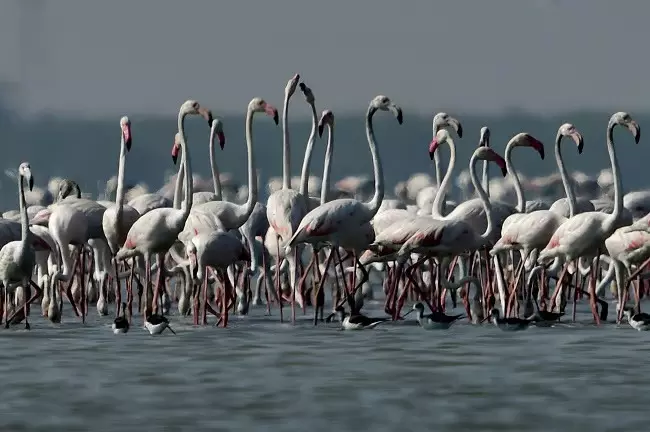Flamingo festival to make grand return in 2025
Tirupati: The wetlands of Pulicat Lake and the Nelapattu Bird Sanctuary in Sullurpet are once again buzzing with activity as thousands of migratory birds arrive for their annual winter sojourn. The visiting species include Greater Flamingos, Grey Pelicans, Painted Storks, Glossy Ibis, Common Kingfishers and Black-Winged Stilts, among others. These avian visitors come from regions as far as Ladakh, Tibet, China, Siberia, Central Asia, Nigeria and even Australia, making the sanctuaries a global hub for migratory birds. This natural spectacle has turned the region into a hotspot for birdwatchers, ornithologists and nature enthusiasts alike every year this season. Starting in mid-October, these sanctuaries — renowned for their biodiversity — serve as the wintering grounds and stopover points for birds migrating from the northern hemisphere. Nelapattu Bird Sanctuary, named after the adjoining village, is Southeast Asia’s largest breeding ground for Grey Pelicans, with approximately 1,500 pelicans nesting there annually. Farmers in the region have a symbiotic relationship with the birds, benefiting from the guano (bird waste) as a natural fertilizer. They protect the birds, often seeing them as "celestial visitors", whose large-scale arrival is seen as a harbinger of good rains and crops. Pulicat Lake complements Nelapattu as a vital feeding ground, enriched by its diverse flora and fauna. Together, the two sanctuaries host over 189 bird species, including 80 migratory ones. Nelapattu is also home to 108 plant species, including dominant varieties like Acacia Arabica and Albizzia Amara. It supports fauna such as scorpion fish, catfish, and freshwater prawns. The birds also feed on prawns found in the water. The sanctuary is a haven for avian diversity, hosting over 189 bird species, including the Spot-billed Pelican, Grey Frigatebird, Black Bittern, Lesser Whistling Teal, Black-capped Kingfisher, Whimbrel, Painted Snipe, Spotted Sandpiper, Gull-billed Tern, Orange-breasted Green Pigeon, Indian Pitta, Loten's Sunbird, Ashy Minivet and Shama, among others. Mammalian life, though less abundant, features notable species such as the Jackal, Black-naped Hare and Jungle Cat. This year, over 13 species of migratory birds have already made their way to the region, with pelicans and flamingos being among the major arrivals. According to ornithologist Ananya Sharma, the migration process is a fascinating phenomenon. “Typically, a few birds arrive first as scouts to assess the conditions, including food availability, water levels and safety,” she explains. Once the environment is deemed favourable, larger flocks follow. The migratory birds primarily feed and breed in the northern part of Pulicat Lagoon, utilising the area as a critical stopover on their long journey. After raising their young, they return to their native habitats, often accompanied by their offspring, thus completing the migratory cycle. Meanwhile, after a four-year hiatus, the much-anticipated Flamingo festival is set to return in January 2025. The event, last held in 2020, was halted due to the COVID-19 invasion and subsequent social and regulatory challenges. Scheduled tentatively from January 17, the three-day event aims to reignite the vibrancy it once showcased, attracting thousands of visitors to Pulicat Lake and Nelapattu Bird Sanctuary. Tirupati district collector Venkateswar has initiated efforts to revive the flamingo festival. He held preparatory meetings with local MLA Vijayasree and officials from tourism and forest departments. Plans include road repairs, enhanced sanitation, security measures and cultural programmes. The fisheries department will oversee safe boating activities, ensuring life jackets and trained lifeguards are available. The Flamingo Festival, conceptualized in 2001, aligns with the arrival of flamingos and other migratory birds during November. The event has grown into a vibrant celebration, promoting tourism while highlighting the ecological importance of the region. This year, the festival will span five key locations including Nelapattu Bird Sanctuary, Atakanitippa Shore Road, BV Palem Pulicat Lake, the Government Junior College in Sullurpet and Sri City. Cultural events, bird-watching tours and competitions will be the main attractions. Collaborations are planned with organisations like the Bombay Natural History Society to enhance its appeal.


Tirupati: The wetlands of Pulicat Lake and the Nelapattu Bird Sanctuary in Sullurpet are once again buzzing with activity as thousands of migratory birds arrive for their annual winter sojourn.
The visiting species include Greater Flamingos, Grey Pelicans, Painted Storks, Glossy Ibis, Common Kingfishers and Black-Winged Stilts, among others. These avian visitors come from regions as far as Ladakh, Tibet, China, Siberia, Central Asia, Nigeria and even Australia, making the sanctuaries a global hub for migratory birds.
This natural spectacle has turned the region into a hotspot for birdwatchers, ornithologists and nature enthusiasts alike every year this season.
Starting in mid-October, these sanctuaries — renowned for their biodiversity — serve as the wintering grounds and stopover points for birds migrating from the northern hemisphere.
Nelapattu Bird Sanctuary, named after the adjoining village, is Southeast Asia’s largest breeding ground for Grey Pelicans, with approximately 1,500 pelicans nesting there annually. Farmers in the region have a symbiotic relationship with the birds, benefiting from the guano (bird waste) as a natural fertilizer.
They protect the birds, often seeing them as "celestial visitors", whose large-scale arrival is seen as a harbinger of good rains and crops.
Pulicat Lake complements Nelapattu as a vital feeding ground, enriched by its diverse flora and fauna. Together, the two sanctuaries host over 189 bird species, including 80 migratory ones. Nelapattu is also home to 108 plant species, including dominant varieties like Acacia Arabica and Albizzia Amara. It supports fauna such as scorpion fish, catfish, and freshwater prawns. The birds also feed on prawns found in the water.
The sanctuary is a haven for avian diversity, hosting over 189 bird species, including the Spot-billed Pelican, Grey Frigatebird, Black Bittern, Lesser Whistling Teal, Black-capped Kingfisher, Whimbrel, Painted Snipe, Spotted Sandpiper, Gull-billed Tern, Orange-breasted Green Pigeon, Indian Pitta, Loten's Sunbird, Ashy Minivet and Shama, among others. Mammalian life, though less abundant, features notable species such as the Jackal, Black-naped Hare and Jungle Cat.
This year, over 13 species of migratory birds have already made their way to the region, with pelicans and flamingos being among the major arrivals. According to ornithologist Ananya Sharma, the migration process is a fascinating phenomenon. “Typically, a few birds arrive first as scouts to assess the conditions, including food availability, water levels and safety,” she explains.
Once the environment is deemed favourable, larger flocks follow. The migratory birds primarily feed and breed in the northern part of Pulicat Lagoon, utilising the area as a critical stopover on their long journey.
After raising their young, they return to their native habitats, often accompanied by their offspring, thus completing the migratory cycle.
Meanwhile, after a four-year hiatus, the much-anticipated Flamingo festival is set to return in January 2025. The event, last held in 2020, was halted due to the COVID-19 invasion and subsequent social and regulatory challenges. Scheduled tentatively from January 17, the three-day event aims to reignite the vibrancy it once showcased, attracting thousands of visitors to Pulicat Lake and Nelapattu Bird Sanctuary.
Tirupati district collector Venkateswar has initiated efforts to revive the flamingo festival. He held preparatory meetings with local MLA Vijayasree and officials from tourism and forest departments. Plans include road repairs, enhanced sanitation, security measures and cultural programmes.
The fisheries department will oversee safe boating activities, ensuring life jackets and trained lifeguards are available.
The Flamingo Festival, conceptualized in 2001, aligns with the arrival of flamingos and other migratory birds during November. The event has grown into a vibrant celebration, promoting tourism while highlighting the ecological importance of the region.
This year, the festival will span five key locations including Nelapattu Bird Sanctuary, Atakanitippa Shore Road, BV Palem Pulicat Lake, the Government Junior College in Sullurpet and Sri City. Cultural events, bird-watching tours and competitions will be the main attractions. Collaborations are planned with organisations like the Bombay Natural History Society to enhance its appeal.






































